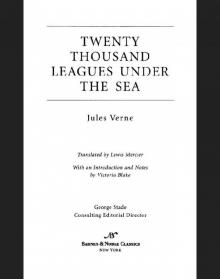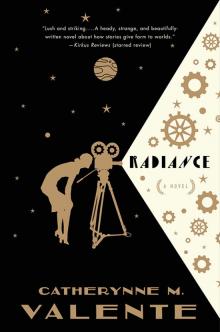


Twenty Thousand Leagues Under the Sea (Barnes & Noble Classics Series)
Jules Verne

Table of Contents
From the Pages of Twenty Thousand Leagues Under the Sea
Title Page
Copyright Page
Jules Verne
The World of Jules Verne and Twenty Thousand Leagues Under the Sea
Introduction
PART ONE
Chapter I - A Shifting Reef
Chapter II - Pro and Con
Chapter III - I Form My Resolution
Chapter IV - Ned Land
Chapter V - At a Venture
Chapter VI - At Full Steam
Chapter VII - An Unknown Species of Whale
Chapter VIII - Mobilis in Mobili
Chapter IX - Ned Land’s Tempers
Chapter X - The Man of the Seas
Chapter XI - All by Electricity
Chapter XII - Some Figures
Chapter XIII - The Black River
Chapter XIV - A Note of Invitation
Chapter XV - A Walk on the Bottom of the Sea
Chapter XVI - A Submarine Forest
Chapter XVII - Four Thousand Leagues Under the Pacific
Chapter XVIII - Vanikoro
Chapter XIX - Torres Straits
Chapter XX - A Few Days on Land
Chapter XXI - Captain Nemo’s Thunderbolt
Chapter XXII - “Ægri Somnia”
Chapter XXIII - The Coral Kingdom
PART TWO
Chapter I - The Indian Ocean
Chapter II - A Novel Proposal of Captain Nemo’s
Chapter III - A Pearl of Ten Millions
Chapter IV - The Red Sea
Chapter V - The Arabian Tunnel
Chapter VI - The Grecian Archipelago
Chapter VII - The Mediterranean in Forty-eight Hours
Chapter VIII - Vigo Bay
Chapter IX - A Vanished Continent
Chapter X - The Submarine Coal Mines
Chapter XI - The Sargasso Sea
Chapter XII - Cachalots and Whales
Chapter XIII - The Iceberg
Chapter XIV - The South Pole
Chapter XV - Accident or Incident?
Chapter XVI - Want of Air
Chapter XVII - From Cape Horn to the Amazon
Chapter XVIII - The Poulps
Chapter XIX - The Gulf Stream
Chapter XX - From Latitude 47° 24’ to Longitude 17° 28’
Chapter XXI - A Hecatomb
Chapter XXII - The Last Words of Captain Nemo
Chapter XXIII - Conclusion
Endnotes
Inspired by Twenty Thousand Leagues Under the Sea
Comments & Questions
For Further Reading
From the Pages of
Twenty Thousand Leagues Under the Sea
The year 1866 was signalized by a remarkable incident, a mysterious and inexplicable phenomenon, which doubtless no one has yet forgotten. (page 5)
The monster emerged some fathoms from the water, and then threw out that very intense but mysterious light mentioned in the report of several captains. This magnificent irradiation must have been produced by an agent of great shining power. The luminous part traced on the sea an immense oval, much elongated, the center of which condensed a burning heat, whose overpowering brilliancy died out by successive gradations. (page 30)
“The sea is everything. It covers seven-tenths of the terrestrial globe. Its breath is pure and healthy. It is an immense desert, where man is never lonely, for he feels life stirring on all sides. The sea is only the embodiment of a supernatural and wonderful existence.” (page 57)
“I owe all to the ocean; it produces electricity, and electricity gives heat, light, motion, and, in a word, life to the Nautilus.” (page 64)
Captain Nemo, by the help of his sextant, took the altitude of the sun, which ought also to give the latitude. He waited for some moments till its disk touched the horizon. While taking observations not a muscle moved; the instrument could not have been more motionless in a hand of marble. (page 74)
Evidently from some part of the vessel they had by means of a tap given entrance to the water, which was invading us, and with which the room was soon filled. A second door cut in the side of the Nautilus then opened. We saw a faint light. In another instant our feet trod the bottom of the sea. (page 86)
At this moment, the Nautilus, raised by the last waves of tide, quitted her coral bed exactly at the fortieth minute fixed by the captain. Her screw swept the waters slowly and majestically. Her speed increased gradually, and sailing on the surface of the ocean, she quitted safe and sound the dangerous passes of the Straits of Torres. (page 128)
“Steam seems to have killed all gratitude in the hearts of sailors.” (page 167)
I returned to the glass. The Nautilus was no longer moving, the heat was becoming unbearable. The sea, which till now had been white, was red, owing to the presence of salts of iron. In spite of the ship’s being hermetically sealed, an insupportable smell of sulphur filled the saloon, and the brilliancy of the electricity was entirely extinguished by bright scarlet flames. I was in a bath, I was choking, I was broiled. (page 186)
At a signal from the captain, its screw was shipped, and its blades raised vertically; the Nautilus shot into the air like a balloon, rising with stunning rapidity, and cutting the mass of waters with a sonorous agitation. Nothing was visible; and in four minutes it had shot through the four leagues which separated it from the ocean, and, after emerging like a flying-fish, fell, making the waves rebound to an enormous height. (pages 218-219)
“Adieu, sun! Disappear, thou radiant orb! Rest beneath this open sea, and let a night of six months spread its shadows over my new domains!” (page 243)
Captain Nemo, covered with blood, nearly exhausted, gazed upon the sea that had swallowed up one of his companions, and great tears gathered in his eyes. (page 270)
If Captain Nemo still inhabits the ocean, his adopted country, may hatred be appeased in that savage heart! (page 296)
Published by Barnes & Noble Books
122 Fifth Avenue
New York, NY 10011
www.barnesandnoble.com/classics
Vingt Mille Lieues sous les mers was originally serialized in France between 1869 and 1870. Lewis Mercier’s translation and slight abridgement of Twenty Thousand Leagues Under the Sea introduced English readers to Verne’s work.
Published in 2005 by Barnes & Noble Classics with new Introduction, Notes, Biography, Chronology, Inspired By, Comments & Questions, and For Further Reading.
Introduction, Notes, and For Further Reading
Copyright © 2005 by Victoria Blake.
Note on Jules Verne, The World of Jules Verne and Twenty Thousand Leagues Under the Sea, Inspired by Twenty Thousand Leagues Under the Sea, and Comments & Questions Copyright @ 2005 by Barnes & Noble, Inc.
All rights reserved. No part of this publication may be reproduced or transmitted in any form or by any means, electronic or mechanical, including photocopy, recording, or any information storage and retrieval system, without the prior written permission of the publisher.
Barnes & Noble Classics and the Barnes & Noble Classics colophon are trademarks of Barnes & Noble, Inc.
Twenty Thousand Leagues Under the Sea
ISBN-13: 978-1-59308-302-5 ISBN-10: 1-59308-302-5
eISBN : 978-1-411-43336-6
LC Control Number 2004112105
Produced and published in conjunction with: Fine Creative Media, Inc. 322 Eighth Avenue New York, NY 10001
Michael J. Fine, President and Publisher
Printed in the United Sta
tes of America
QM
5 7 9 10 8 6 4
Jules Verne
The creator of the roman scientifique, the popular literary genre known today as science fiction, Jules Gabriel Verne was born in the port town of Nantes, France, in 1828. His father, Pierre, was a prominent lawyer, and his mother, Sophie, was from a successful ship-building family. Despite his father’s wish that he pursue law, young Jules was fascinated by the sea and all things foreign and adventurous. Legend holds that at age eleven he ran away from school to work aboard a ship bound for the West Indies but was caught by his father shortly after leaving port.
Jules developed an abiding love of science and language from a young age. He studied geology, Latin, and Greek in secondary school, and frequently visited factories, where he observed the workings of industrial machines. These visits likely inspired his desire for scientific plausibility in his writing and perhaps informed his depictions of the submarine Nautilus and the other seemingly fantastical inventions he described.
After completing secondary school, Jules studied law in Paris, as his father had before him. However, during the two years he spent earning his degree, he developed more consuming interests. Through family connections, he entered Parisian literary circles and met many of the distinguished writers of the day. Inspired in particular by novelists Victor Hugo and Alexandre Dumas (father and son), Verne began writing his own works. His poetry, plays, and short fiction achieved moderate success, and in 1852 he became secretary of the Theatre lyrique.
In 1857 he married Honorine Morel, a young widow with two children. Seeking greater financial security, he took a position as a stockbroker with the Paris firm Eggly and Company. However, he reserved his mornings for writing. Baudelaire’s recently published French translation of the works of Edgar Allan Poe, as well as the days Verne spent researching points of science in the library, inspired him to write a new sort of novel: the roman scientifique. His first such novel, Five Weeks in a Balloon, was an immediate success and earned him a publishing contract with the important editor Pierre-Jules Hetzel.
For the rest of his life, Verne published an average of two novels a year; the fifty-four volumes published during his lifetime, collectively known as Voyages Extraordinaires, include his best-known works, Around the World in Eighty Days and Twenty Thousand Leagues Under the Sea. Begun in 1865 and published to huge success in 1869, Twenty Thousand Leagues has been translated into 147 languages and adapted into dozens of films. The novel also holds the distinction of describing a submarine twenty-five years before one was actually constructed. As a tribute to Verne, the first electric and nuclear submarines were named Nautilus.
In 1872 Verne settled in Amiens with his family. During the next several years he traveled extensively on his yachts, visiting such locales as North Africa, Gibraltar, Scotland, and Ireland. In 1886 Verne’s mentally ill nephew shot him in the leg, and the author was lame thereafter. This incident, as well as the tumultuous political climate in Europe, marked a change in Verne’s perspective on science, exploration, and industry. Although not as popular as his early novels, Verne’s later works are in many ways as prescient. Touching on such subjects as the ill effects of the oil industry, the negative influence of missionaries in the South Seas, and the extinction of animal species, they speak to concerns that remain urgent in our own time.
Verne continued writing actively throughout his life, despite failing health, the loss of family members, and financial troubles. At his death in 1905 his desk drawers contained the manuscripts of several new novels. Jules Verne is buried in the Madeleine Cemetery in Amiens.
The World of Jules Verne and Twenty Thousand Leagues Under the Sea
1828 Jules Gabriel Verne is born in the port city of Nantes, France, the first of the five children who will be born to Pierre and Sophie Allotte Verne. His father, an attorney, will encourage young Jules to pursue a career in law. His mother, from a ship-building family, instills in him a love of the sea.
1831 Victor Hugo’s Notre-Dame de Paris (The Hunchback of Notre Dame) is published.
1833 George Sand’s novel Lélia is published by the well-known publisher Pierre-Jules Hetzel, who later will publish Verne’s novels.
1834 Jules begins attending secondary school. During his years at school, he excels in geology, Latin, and Greek. Also greatly interested in machinery, he makes frequent visits to nearby factories.
1839 It is said that the adventurous boy tries to run away to sea aboard a ship bound for the West Indies but is apprehended by his father before reaching open waters.
1843 Tahiti becomes a French protectorate.
1844 Alexandre Dumas’s Le Comte de Monte Cristo (The Count of Monte Cristo) is published.
1847 Jules begins studying law in Paris; he will receive his degree in two years. In Paris, family friends introduce him to some of France’s most distinguished writers, including Victor Hugo. Jules begins writing to supplement his meager allowance. Several of his plays are well received in theaters; his fiction appears in the Parisian magazine Musée des familles.
1852 Louis- Napoléon becomes emperor of France as Napoleon III. Novelists Alexandre Dumas (pére and fils) secure Verne a position as secretary of the Theatre lyrique.
1853 French administrator Georges-Eugène Haussmann begins alterations and municipal improvements in Paris, including the construction of the wide boulevards that distinguish the city to this day. The Crimean War begins, pitting Russia against France, England, and the Ottoman Turks.
1854 French poet Charles Baudelaire’s translation of the works of Edgar Allan Poe captivates Verne and initiates his lifelong admiration of the American author.
1857 Verne marries the widow Honorine de Viane Morel, whom he had met the previous year. Quitting his position at the Theatre lyrique, he embarks on a career as a stockbroker at Eggly and Company, although he continues to devote his mornings to writing. Charles Baudelaire’s volume of poems Les fleurs du mal (The Flowers of Evil) and Gustave Flaubert’s novel Madame Bovary are published.
1859 Verne spends hours in the library gaining the scientific knowledge that will inform his fiction. He travels to England and Scotland. English naturalist Charles Darwin’s On the Origin of Species by Means of Natural Selection is published. Work begins on the Suez Canal.
1861 Verne travels to Norway and Denmark. His son and only child, Michel, is born. He meets the legendary photographer Nadar.
1862 Verne’s manuscript Cinq semaines en ballon (Five Weeks in a Balloon) is accepted by Hetzel for publication. Until his death, Verne will publish an average of two books a year with Hetzel, forming the cumulative series known as Voyages ex- traordinaires (Extraordinary Voyages). Hugo’s Les Misérables appears.
1863 Five Weeks in a Balloon is published to great success.
1864 Voyage au centre de la Terre (Voyage to the Center of the Earth) is published. Verne writes an article on Poe for Musée des familles.
1865 De la Terre à la Lune (From the Earth to the Moon) appears. English writer Lewis Carroll’s Alice’s Adventures in Wonderland is published.
1866 Voyages et aventures du capitaine Hatteras (The Adventures of Captain Hatteras) is published.
1867 Verne travels with his brother Paul to New York aboard the Great Eastern. Les enfants du capitaine Grant (The Children of captain Grant) is published.
1868 Captain published. He purchases his first yacht, the Saint-Michel, named for his only son
1869 Vingt mille lieues sous les mers (Twenty Thousand Leagues Under the Sea) is published in two volumes (1869-1870). Its depiction of the submarine Nautilus (named after the first submarine, invented around 1800 by American engineer Robert Fulton) predates the construction of the first submarine by twenty-five years.
1870 The Franco-Prussian War breaks out; Verne serves in the Coast Guard.
1871 Une ville flottante (A Floating City), partly inspired by a trip to Niagara Falls, New York, is published. Verne’s father dies. The Franco-Prussian War ends.
1873 Another Verne masterpiece, Le tour du monde en quatre vingts jours (Around the World in Eighty Days), is published. French poet Arthur Rimbaud’s confessional autobiography Une Saison en Enfer (A Season in Hell) is published.
1874 Le Docteur Ox (Dr. Ox’s Experiment and Other Stories) appears, along with L‘Île mystérieuse (The Mysterious Island). Around the World in Eighty Days is adapted for the stage. Verne purchases a new yacht, the Saint-Michel II.
1875 Le Chancellor (The Chancellor) is published.
1876 Michel Strogoff is published.
1877 Les Indes noires (The Child of the Cavern) and Hector Servadac are published. Verne buys his last yacht, the Saint-Michel III.
1878 A leisurely cruise aboard the Saint-Michel III takes Verne and his brother to North Africa, Portugal, and Gibraltar.
1879 Les Cinq cents millions de la Bégum (The Begum’s Fortune) and Les tribulations d’un Chinois en Chine (The Tribulations of a Chinaman in China) are published.
1880 Verne cruises to Scotland and Ireland. La Maison a vapeur (The Steam House) is published.
1881 Verne cruises to Holland, Denmark, and Germany. La Jan-gada (The Giant Raft) is published.
1882 Verne moves his family to a larger house in Amiens with a circular tower; today it is a well-known Verne landmark and the headquarters of the Jules Verne Society in Amiens.














